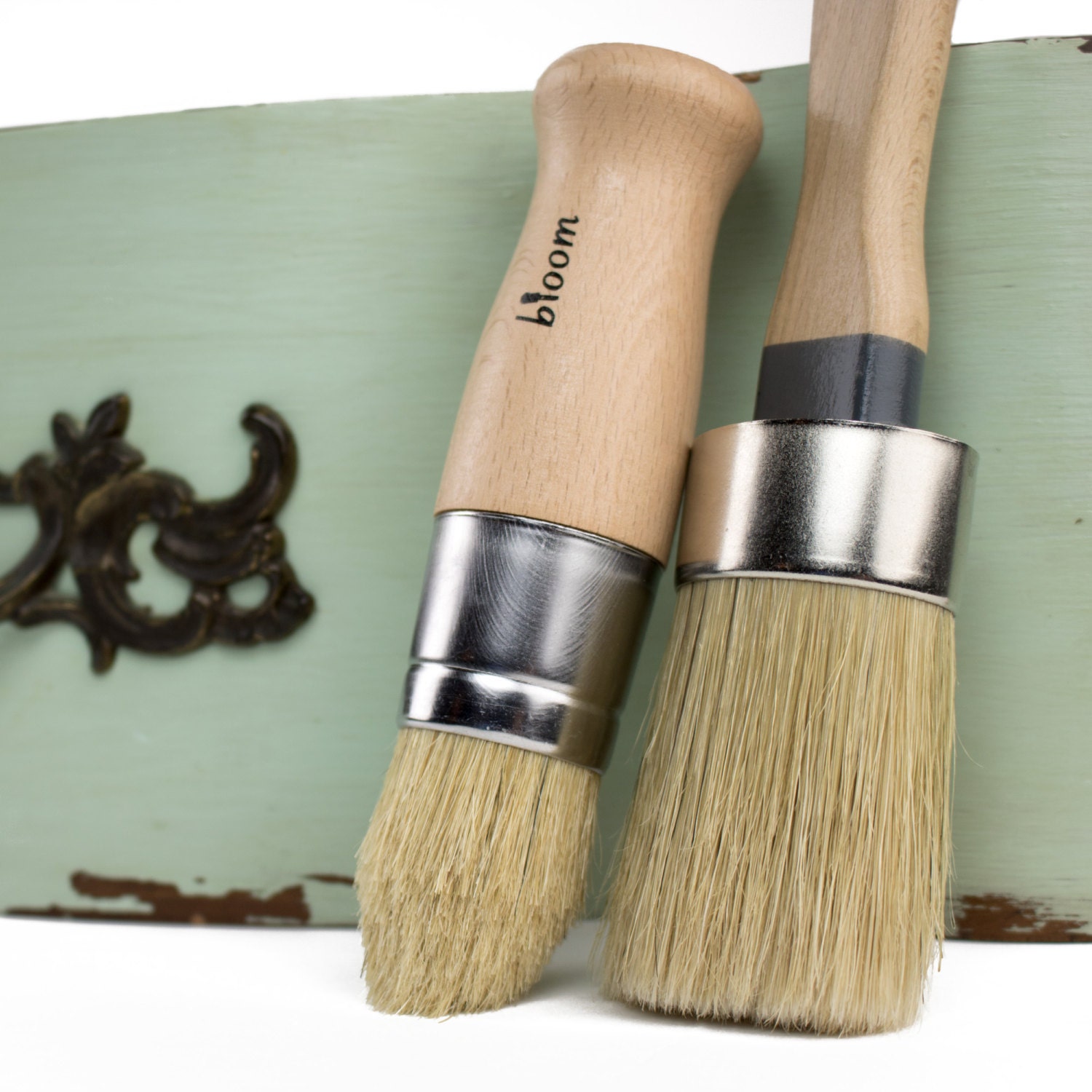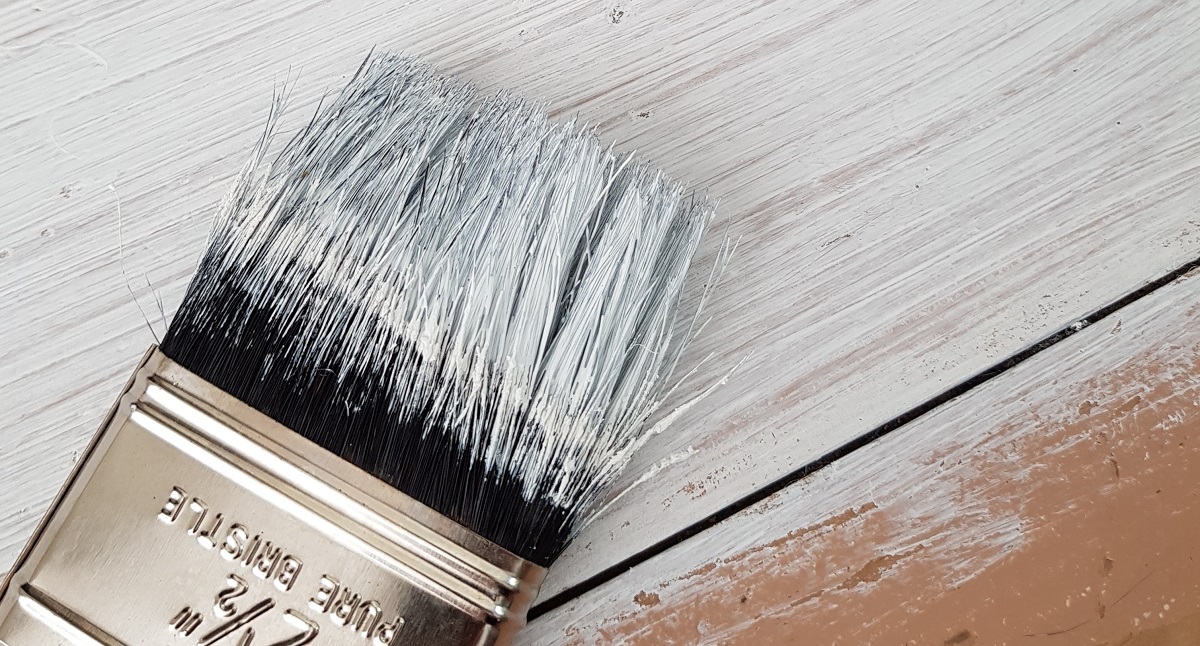Cling On brushes come in 6 shapes: Round, Oval, Flat Bent, Block and Shorty. The brushes are extremely durable, have the best shape retention, can be used with all water based products, are easy to clean,
are superb with cutting in, and provide a better coverage with a smoother finish.
Find Chalky Paint paint brushes at Lowe's today. Shop paint brushes and a variety of paint products online at Lowes.com. Brush Strokes in Chalk Paint. Brush strokes show up for a few different reasons. Cause: The Paint is Too Thick. Some brands are thicker than others. How to Fix It: You can combat this a bit by dipping the paint brush in water before dipping the brush into the paint. You can also avoid that brand in the future.

Bent Brushes (P series): Bent brushes are perfect for painting in hard to reach corner and cabinets, inside drawers and awkward spots.

Oval Brushes (O Series): Oval brushes are a go to for most pieces. The size of the brush depends on what you are working on.
Round Brushes (R Series): Round brushes are idea for narrow and small clean lines. Great for working on edges and trim.
Flat brushes (F Series): Flat brushes are great for large flat surfaces, doors, large flat furniture pieces like armoires and desks, everyone seems to like the comfort of a flat brush.

Shorty Brush (S Series): Shorty brushes are a best seller for sure! The short handle makes it easy to hold and paint.
Block Brush (B Series) These giant block brushes are ideal for applying poly, stain, varnish, color washes, and painting walls. This is one mammoth block brush and believe me, you will find it useful on large projects!
CARE AND USAGE TIPS FOR YOUR CLING ON BRUSH:

-Always wet your Cling On Brush before using, this allows the filaments to to absorb the water, not your paint and allows for much easier flow and easier cleaning. Keep your brush wet! This takes some getting used to, but, if you can keep a bucket of water next to you when you paint and re wet your brush from time to time. Dab off excess on a paper towel to get the excess water off and continue to paint.
-DO NOT REMOVE THE STRINGS, these will help keep your brushes in tip top shape
-DO NOT wrap your brush in plastic wrap or plastic bag
-To clean, you can put your brush in a jar of water, not up past the ferrule (metal part) try to not let it sit on the bottom of the container. Let it rest like this between coats and when you go to use again just take excess water off and paint. To clean, just use water and if you want to keep your brush in tip top shape you can use dawn soap or a good quality brush soap.
Turn forgettable furniture and ho-hum surfaces into showstopping home accents with this versatile and low-maintenance paint finish.
Photo: istockphoto.com
Putting a new face on tired-looking home accents can be as simple as brushing on a few coats of paint. But if you want to achieve a unique antique-style finish, think outside the conventional can of latex paint and opt for chalk paint instead.
A water-based decorative paint developed and made popular by Annie Sloan, chalk paint is a nondamaging blend of calcium carbonate, talc, and pigments that delivers a whimsical matte white finish with chalk-white undertones. It has become the veneer of choice for DIYers looking to revive their outdated wooden furnishings, although it’s also suitable for use on masonry, drywall, metal, glass, and fabric.
Here’s how to use chalk paint—along with a list of basic painting tools and some useful information about techniques—to produce an appealing distressed finish on nearly any surface.
Step 1
If possible, work on your paint project indoors—chalk paint adheres best at room temperature. Protect the floor of your work space from paint splatter by laying out newspaper or brown paper underneath the item you’re painting. Detach any removable elements from the piece, including chair cushions, shelves, drawers, hinges, knobs, and other hardware.
Step 2
You can generally skip sanding and priming before applying chalk paint, even when working with varnished wood pieces, because the paint can adhere to most surfaces. Even so, some furniture finishes warrant special treatment before painting:
- Paint-covered, rust-covered, or high-gloss surfaces like laminates could use a light sanding with 150-grit or finer sandpaper in order to remove obstacles to adhesion.
- Untreated wood should have a coat of clear shellac applied with a cloth pad before painting; cure it according to the manufacturer’s instructions. This coat prevents tannins in the wood from bleeding into the paint and altering the color.
Using a soft cloth saturated in soapy water, wipe down the entire surface of the piece to lift dirt, debris, oil, and sanding dust. Give the surface a once-over with a clean, damp cloth, then let it dry fully. Cover any areas you don’t want to paint with painter’s tape.
Photo: istockphoto.com
Step 3
Purchase enough chalk paint in your favorite shade to cover the piece you’re working on. (Typically, a liter of chalk paint can cover 140 square feet—roughly the surface area of a small dresser.) Before opening the paint can, turn it upside down to loosen the contents, then shake it vigorously to ensure that the chalk paint is well mixed.
Step 4
Depending on the size of the object you’re painting, you can opt to use a brush, roller, or spray gun to apply chalk paint. How you apply the paint will depend on your applicator of choice:
- To use chalk paint with a brush: For a smooth, uniform finish, choose a natural-bristle brush with long, flexible bristles. Dip the brush into the can, and tap the handle against the lid of the can to remove excess paint. Then, apply the paint in unidirectional strokes to one section of the piece at a time until the entire surface is covered.
- To use chalk paint with a roller: Pour the chalk paint into a paint pan, then load it onto a high-density foam roller (depending on the size of the furniture, a four-inch mini roller may be the best option). Scrape off the excess paint on the grid of the pan. Roll a thin layer of paint in a long, unidirectional stroke, then pull it back and make one more stroke in the original direction. Repeat this process until the entire surface is coated.
- To use chalk paint with a spray gun: Chalk paint is a naturally thick medium that may not flow readily from all spray guns. You can get around this by watering down the chalk paint (adding approximately two tablespoons of water for every cup of paint) before loading it into the gun. Or, you can opt to load the paint as is and operate the gun at maximum pressure, preferably with a spray tip measuring at least 1.8 millimeters to enable the fluid to flow. To avoid risking damage to your spray gun, test this method on a small, inconspicuous part of the piece before tackling larger areas.
Allow the first coat to dry completely according to the manufacturer’s instructions.
Chalk Pro Paint Brushes

Step 5
A single coat of chalk paint is sufficient for many applications. If, however, you need to cover any visual imperfections, or if you want to create a two-tone decorative finish in which the bottom layer of paint shows through around the distressed edges, you can opt to apply a second coat in the same color or a lighter shade.
Chalk Paint Brushes At Lowe's
Step 6
Chalk Paint Brushes Hobby Lobby
Now, examine the finish. If you want a more polished matte look, keep it as is; otherwise, to achieve a subtly worn patina—a finish that chalk paint is famous for—distress the painted surface with medium-grit sandpaper, focusing on the edges or details you want to accentuate.
Step 7
When you’re happy with the finish, seal the paint with one or more coats of clear or tinted wax, gently massaging the wax into the painted surface with a soft wax brush. As a rule of thumb, use a 500-milliliter tin of wax for every three to four liters of paint. Although wax can dry in less than a half hour, it’s best to let it sit overnight. Total curing of the wax can take up to three weeks, although the furniture is ready to use as soon as the wax is dry.
Step 8
Chalk Paint Brushes Menards
Finally, reinstall any hardware you removed from the piece, and let your chalk-painted accent shine!
